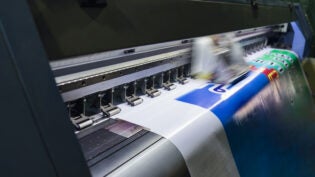
For years, advertising creatives have relied on their instincts to make decisions when producing campaign content, whether it’s making a font size bigger, moving an image from left to right, or choosing vendors to realize their ideas. Those decisions are usually based on gut instinct, previous experience, and the occasional market research—certainly not on anything as insightful as neuromarketing.
As CEO of Saddington Baynes, a creative production company located in the UK, Chris Christodoulou knows those decisions well from his time as a digital retoucher sitting alongside creatives and photographers. Saddington Baynes specializes in automotive CGI imagery in cross-platform campaigns for the likes of Honda, Cadillac, Nissan, and others.
“As creatives ourselves, we work hard to synchronize our left brain, which governs language and reason, and right brain, which governs vision and emotion,” Christodoulou says. “When working with creatives, we need to get inside their heads to be able to visually articulate what they want to communicate and what they want to see. More importantly, we want to create imagery that makes people feel something. Using words to describe a visual concept is appealing to the wrong side of the brain.”
What’s more, the success of any campaign is difficult to measure. When it comes to predicting consumer behavior, for example, focus groups have flaws. Participants cannot accurately articulate their implicit (subconscious or automatic) emotions, and the very act of asking them to try then alters those emotions. Take the Guinness surfer ad, one of the UK’s most famous commercials: The results from focus groups suggested that the agency should have rejected it.
Christodoulou found that more often than not, he made campaign-image decisions simply based on what “felt” right. But then he read the groundbreaking 2009 study Brand Immortality: How Brands Can Live Long and Prosper, by Hamish Pringle and Peter Field.
The study, on behalf of the Institute of Practitioners in Advertising (IPA), found that the key to the most successful ads from the previous 10 years was emotion. Those campaigns that employed emotional rather than rational messages “more effectively deliver[ed] business results including profitability, share growth, and improved price elasticity.”
After reading the study, learning that 95 percent of the consumer decision-making process is subconscious, and attending a Warc seminar that focused on scientifically measuring what people are feeling, Christodoulou realized there must be a better way to measure the potential success of a campaign before it runs, not after.
“There was a lot of talk about measuring the emotional aspects after the content had launched,” he says. “This seemed to me to be too late. Why couldn’t it be done before the campaign ran?”
To explore that idea, Saddington Baynes partnered with Thom Noble, the eminent UK applied neuroscience specialist from NeuroStrata, to develop Engagement Insights™, a tool that measures emotional engagement, visual saliency, and brand fit during the production of campaign visuals, allowing Saddington Baynes to optimize the image along the way.
“Engagement Insights™ gives clients the comfort that the image we create will be on target and resonate emotionally with the audience the client is trying to reach,” Christodoulou says. “This is a world first for a production company.”
Engagement Insights™ uses online implicit testing, which measures subconscious responses to visual stimuli and, in turn, the subconscious engagement of the test subjects. It measures response patterns and perceptual shifts in milliseconds, before conscious processing kicks in. Nonconscious implicit testing is more predictive of consumer behavior, according to Noble.
The process tests campaign imagery at various stages, from previsualization through final grading, against a set of predefined attributes. This can be a generic set or one bespoke to the brand, such as stylish, refined, dynamic, exciting, I want, innovative, premium, and trusted. The respondent sample is based on buyer demographics—such as age, gender, and location—that are important to the brand. The generic test can return results within 24–48 hours whereas a more tailored study takes one week to 10 days.
The test is devised by neuroscientists to evaluate the degree to which different images trigger associations in the mind with those specific, predefined attributes.
To generate multiple image variants, the team uses Autodesk VRED and Autodesk Maya during the tests. “VRED helps to get the images out quickly,” Christodoulou says. “It’s a versatile real-time CGI rendering tool that allows us to explore composition and alternate scenes extremely quickly. Maya provides more sophistication and control for finely tuned photo-realistic imagery.”
For example, while assessing images for a Honda HR-V campaign, the team tested individual visual ingredients that could make a big impact to the final image: the camera lens, the car angle, and different locations. Keeping everything else the same, the team changed the camera angle to see what would happen: One angle of an outdoor shot registered as more premium; another was viewed as more stylish. Then, keeping the same angle but changing the background from an outdoor scene to a studio backdrop made the image appear more believable.
Neuroscience has shown that due to the wiring in the brain, humans have an inherent tendency to more readily decode material that has the image on the left and text on the right. In a busy, cluttered media environment, this kind of rapid processing is likely to lead to more effective communication. However, the accepted layout norm has been the opposite: text left, image right.
Saddington Baynes is the first production company to use implicit System 1 techniques to gauge emotional response to imagery. But according to Christodoulou, many leading companies—such as Google, Coca-Cola, P&G, BMW, PayPal, Cisco, and NBC—have been adopting cognitive-neuroscience practices for research and development, product design, branding, and packaging. These companies are reshaping their marketing by improving their understanding of consumer perception and its impact on behavior.
“In today’s multichannel market, users are bombarded with thousands of brand messages each day,” Christodoulou says. “Imagery does the heavy lifting of drawing attention, but how do you engage your consumer and really stand out? By having a better understanding of emotional response patterns and those nonconscious triggers and cues that help develop images that are distinct to your brand and more effective for your intended audience.”












